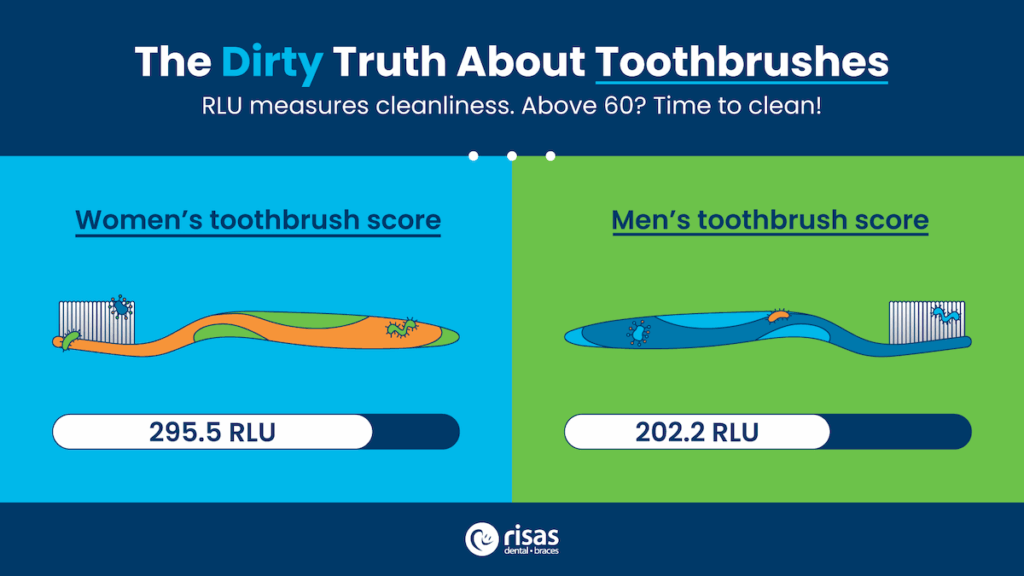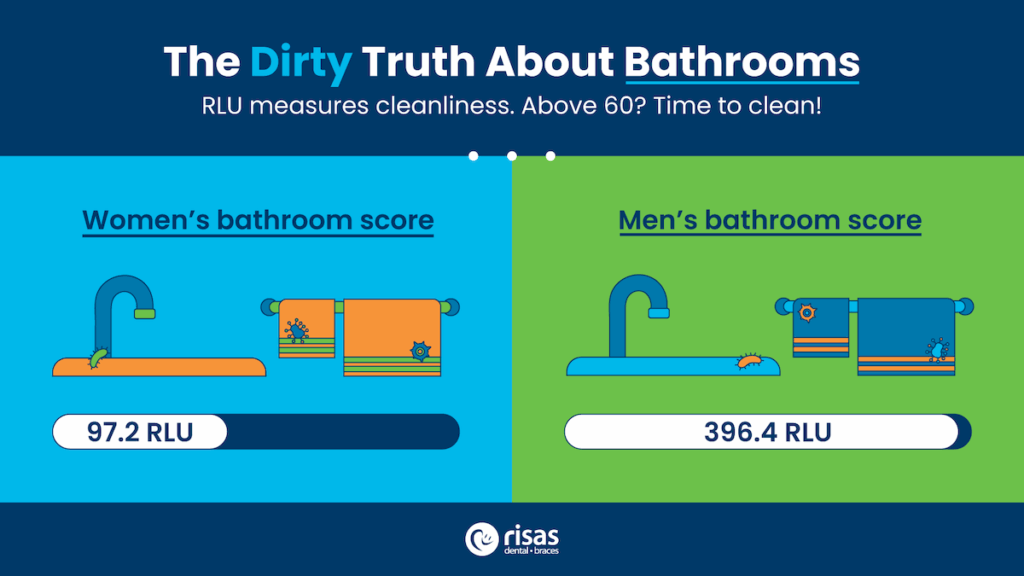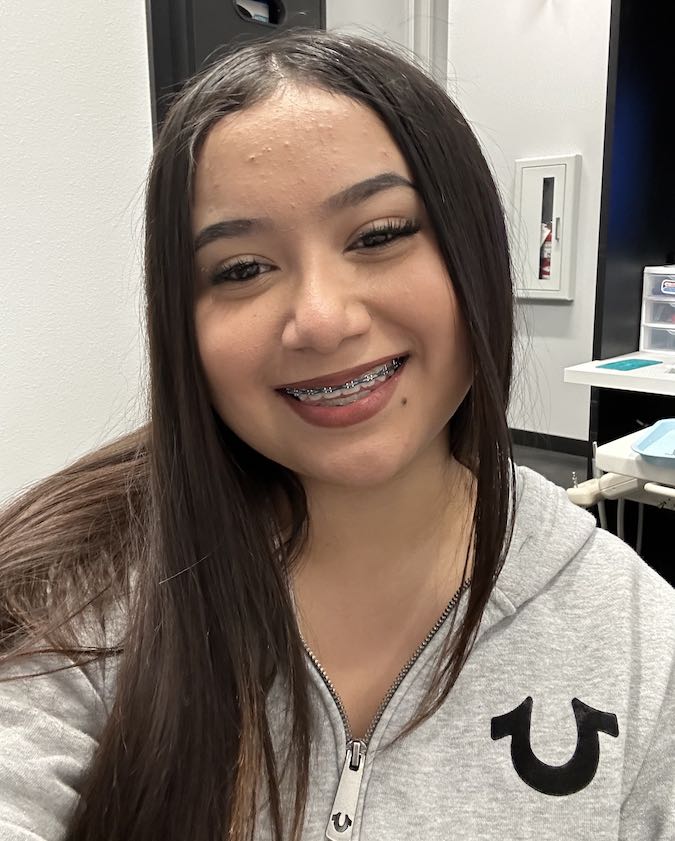A single toothbrush can harbor more than one million bacteria—a shocking statistic when you consider that its purpose is to keep your mouth clean and healthy.
To uncover just how much bacteria is really lurking, the team at Risas Dental conducted an experiment using an advanced ATP bioluminescence testing method. We’ve measured the amount of adenosine triphosphate - a molecule found in and around living cells – on each of our participants’ toothbrushes.
Swabs were taken using Hygiena’s UltraSnap Surface ATP Test and EnSURE Touch monitoring system to provide RLU (Relative Light Unit) readings. And the higher the RLU result, the more bacteria present.
But are there differences between the cleanliness of our male and female participants’ toothbrushes? And what about other areas in their bathrooms? Let’s dive in to find out just how clean (or dirty) the average American toothbrush really is…

How clean are Americans’ toothbrushes?
Our research has uncovered some eye-opening results about the cleanliness of American toothbrushes.
The average RLU level for a toothbrush owned by a female participant sits at 295.5 RLU, while the acceptable range for cleanliness is between just 20-60. We did find variation however, with one toothbrush having a relatively low level of 80, while another showed a level of 3,837 RLU. Other brushes fell in the 134, 161, and 558 RLU range.
But what about our male participants? Well, the average RLU level was slightly lower (coming in at 202.2), yet we also found some significantly high figures. On two of the toothbrushes we swabbed, we found elevated RLU levels of 3,248 and 4,635.

Bathroom cleanliness levels
Next, let’s take a look at the cleanliness levels in our participants’ bathrooms. The average female bathroom RLU score sits at 97.2, while we found a higher average score of 396.4 when swabbing male bathrooms.
Swabbing specific areas like door handles, sinks, and taps also revealed some interesting differences.
Female bathroom door handles are significantly cleaner (98 RLU compared to 457). Similarly, female participants’ bathroom sinks were also noticeably cleaner, with the right side of their sinks showing RLU levels of just 24, while male sinks showed an average of 668.
While the tap area in our male bathrooms had a slightly lower RLU of 252, female bathroom taps still came in cleaner (120 RLU).
Toothbrush cleanliness: What do the experts have to say?
To gain some professional insight, we asked Dr. Singh, from Winit Clinic, to shed some light on our findings:
“I've seen alarming data with high RLU levels associated with toothbrushes and sink basins. ATP bioluminescence testing provides an excellent measure of organic contamination, and with values as high as 4,635, it is likely that there is extensive presence of micro-organisms such as bacteria and biofilm. With the range for acceptability pegged between 20 and 60 RLU, toothbrushes and their environments are clearly well outside the cleanliness thresholds. This means that, unknowingly, people might be exposing themselves to bacteria every time they brush.”
“One of the most significant risks associated with using a contaminated toothbrush is that it could lead to oral infections. Once the pathogens settle on the bristles, they get introduced into the oral cavity, where they can cause gum disease, contribute to cavities, and even lead to systemic infections in those with low immunity. Long-term use of a contaminated toothbrush could be devastating to the oral microbiome, as it predisposes the mouth to colonization by more pathogenic bacteria, which then results in chronic inflammation of the gums and possibly other mouth-related complications.”
“Cross-contamination is another issue. Having toothbrushes stored in proximity in an unhygienic atmosphere creates the right environment for the bacteria to migrate from one brush to the other. High bacterial loads in shared bathroom spaces can promote the spread of illness-causing germs such as those associated with some gastrointestinal- and airway-tract infections. Since almost all of the places have high ATP, these areas definitely serve as important niches for bacterial growth. This reinforces the need to disinfect toothbrushes frequently, store them upright in a dry place, and replace them every three months or earlier if the bristles become worn or dirty.”
How to maintain optimal toothbrush hygiene
The good news is, with a bit of guidance, keeping your brush clean is relatively easy. Dr David Ryan, DMD at Risas Dental shares some top tips below:
- Storage matters: “Most people store their toothbrushes in a holder on their sink, however this can expose them to high levels of bacteria. Storing your brush in an upright position, as far away from the toilet as possible, can help reduce bacterial exposure. Also avoid using toothbrush caps, as they can trap in moisture promoting bacterial growth.”
- Rinsing isn’t enough: “While rinsing your brush after each use is helpful, you’ll need to give it a deeper clean every once in a while, too. Soak it in antibacterial mouthwash or a 3% hydrogen peroxide solution for 3-5 minutes. Afterwards, rinse thoroughly with warm water.”
- When to replace it: “It’s important to replace your toothbrush every 3-4 months (or sooner if the bristles start to fray). A well-worn brush is a breeding ground for bacteria, and it won’t clean your teeth effectively.”
While a clean toothbrush is crucial for your oral health, Dr Ryan also explains how important it is to choose the right type of brush and incorporate additional steps into your routine:
- Choose the right tools: "Not all toothbrushes are created equal, soft-bristled brushes are generally the safest and most effective for removing plaque without damaging your enamel or irritating your gums. Whether manual or electric, what matters most is your technique and consistency."
- Don't brush alone: "Your toothbrush is just one part of complete oral hygiene routine. Be sure to floss daily to remove food and plaque from between your teeth, where your brush can't reach. Adding an antibacterial mouthwash can also help reduce harmful bacteria and keep your breath fresh."
- Keep it personal: "Never share your toothbrush, even with family members, as this can spread germs and increase your risk of infections. Also, make sure each toothbrush in your household is clearly marked to avoid mix-ups."
When in doubt, ask your dentist: "If you're unsure whether you're using the right brush or following the best routine for your specific needs, your dentist can help you customize your oral care for maximum effectiveness."
Well, there we have it: our insights on how clean (or dirty) the average American toothbrush really is.
Brushing plays a key role in keeping our mouths healthy, but its effectiveness relies on proper care, storage, and regular cleaning. So, follow the above tips, and ensure you’re prioritizing brush cleanliness for a healthy smile.
And if you’re due for a check-up soon, find a location near you and book with Risas Dental today. From exams to cleanings and extractions, we offer a variety of affordable services and expert oral health guidance.
Methodology
The tests were conducted using an ATP bioluminescence test, which measures the amount of adenosine triphosphate - a molecule found in and around living cells - on a particular surface, indicating the level of cleanliness.
Swabs were taken using Hygiena’s UltraSnap Surface ATP Test and EnSURE Touch monitoring system to determine RLU results.

